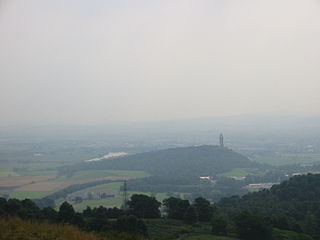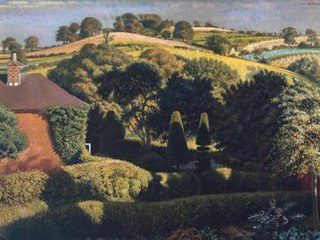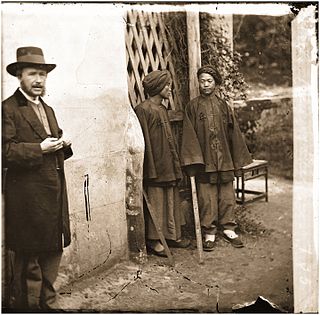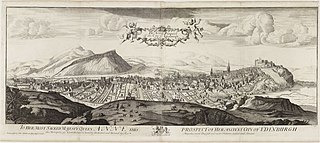
Edinburgh is the capital city of Scotland and one of its 32 council areas. The city was historically part of the county of Midlothian, but was administered separately from the surrounding county from 1482. It is located in Lothian on the southern shore of the Firth of Forth. Edinburgh is Scotland's second-most populous city, after Glasgow, and the seventh-most populous city in the United Kingdom.

The Victoria and Albert Museum in London is the world's largest museum of applied arts, decorative arts and design, housing a permanent collection of over 2.27 million objects. It was founded in 1852 and named after Queen Victoria and Prince Albert.

Nottingham Castle is a Stuart Restoration-era ducal mansion in Nottingham, England, built on the site of a Norman castle built starting in 1068, and added to extensively through the medieval period, when it was an important royal fortress and occasional royal residence. In decline by the 16th century, the original castle, except for its walls and gates, was demolished after the English Civil War in 1651. The site occupies a commanding position on a natural promontory known as "Castle Rock" which dominates the city skyline, with cliffs 130 feet (40 m) high to the south and west.

A crag is a rocky hill or mountain, generally isolated from other high ground.

Holyrood Park is a royal park in central Edinburgh, Scotland about 1 mile to the east of Edinburgh Castle. It is open to the public. It has an array of hills, lochs, glens, ridges, basalt cliffs, and patches of gorse, providing a wild piece of highland landscape within its 650-acre (260 ha) area. The park is associated with the royal palace of Holyroodhouse and was formerly a 12th-century royal hunting estate. The park was created in 1541 when James V had the ground "circulit about Arthurs Sett, Salisborie and Duddingston craggis" enclosed by a stone wall.

Arthur's Seat is an ancient volcano which is the main peak of the group of hills in Edinburgh, Scotland, which form most of Holyrood Park, described by Robert Louis Stevenson as "a hill for magnitude, a mountain in virtue of its bold design". It is situated just to the east of the city centre, about 1 mile (1.6 km) to the east of Edinburgh Castle. The hill rises above the city to a height of 250.5 m (822 ft), provides excellent panoramic views of the city and beyond, is relatively easy to climb, and is popular for hillwalking. Though it can be climbed from almost any direction, the easiest and simplest ascent is from the east, where a grassy slope rises above Dunsapie Loch. At a spur of the hill, Salisbury Crags has historically been a rock climbing venue with routes of various degrees of difficulty. Until recently rock climbing was restricted to the South Quarry, but access is currently banned altogether by Historic Environment Scotland.

Paul Sandby was an English map-maker turned landscape painter in watercolours, who, along with his older brother Thomas, became one of the founding members of the Royal Academy in 1768.

This article is a timeline of the history of Edinburgh, Scotland, up to the present day. It traces its rise from an early hill fort and later royal residence to the bustling city and capital of Scotland that it is today.

Douglas Percy Bliss was a Scottish painter and art conservationist. Bliss's family was of Northamptonshire, England. His grandfather moved to Moray, Scotland. Bliss himself was born in Karachi, India. Bliss was raised in Edinburgh and educated at George Watson's College from 1906–17. He always regarded himself as Scottish.

Wilhelmina Barns-Graham CBE was one of the foremost British abstract artists, a member of the influential Penwith Society of Arts.

John Thomson FRGS was a pioneering Scottish photographer, geographer, and traveller. He was one of the first photographers to travel to the Far East, documenting the people, landscapes and artefacts of eastern cultures. Upon returning home, his work among the street people of London cemented his reputation, and is regarded as a classic instance of social documentary which laid the foundations for photojournalism. He went on to become a portrait photographer of High Society in Mayfair, gaining the Royal Warrant in 1881.

A print room is a room in an art gallery or museum where a collection of old master and modern prints, usually together with drawings, watercolours, and photographs, are held and viewed.

Iain Macnab of Barachastlain was a Scottish wood-engraver and painter.

Scottish renaissance painted ceilings are decorated ceilings in Scottish houses and castles built between 1540 and 1640. This is a distinctive national style, though there is common ground with similar work elsewhere, especially in France, Spain and Scandinavia. An example in England, at Wickham, Hampshire, was recorded in 1974. There are records of over 100 examples, and a much smaller number of painted ceilings survive in-situ today. Some salvaged painted beams and boards are stored by Historic Environment Scotland. The paintings at Crathes Castle, dating from 1597 and 1602 are probably the best known.

Alison Kinnaird MBE, MA, FGE is a glass sculptor, Celtic musician, teacher and writer born in Edinburgh, Scotland. She is one of the foremost and most original modern glass engravers in Scotland.

Calderwood Castle was located in East Kilbride, Scotland. The castle was situated near the banks of the Rotten Calder Water in what is now Calderglen Country Park. Most likely constructed in the early to mid fifteenth century by the Maxwell family, the original peel tower collapsed in 1773. It was replaced by an extension to a large 18th-century country house called Calderwood House, which has itself since been demolished along with a later 1840s Gothic Revival addition.

Hugh William Williams FRSE (1773–1829), known as "Grecian Williams," was a Scottish landscape painter.

The following outline is provided as an overview of and topical guide to Edinburgh:

Jennifer Elizabeth Lee is a Scottish ceramic artist with an international reputation. Lee's distinctive pots are hand built using traditional pinch and coil methods. She has developed a method of colouring the pots by mixing metallic oxides into the clay before making. Her work is held in over forty museums and public collections worldwide, including the Metropolitan Museum of Art in New York, the Philadelphia Museum of Art, the Los Angeles County Museum and the Victoria and Albert Museum. In 2018 Lee won the Loewe Craft Prize, an award initiated by Jonathan Anderson in 2017. The prize was presented to her at an awards ceremony at The Design Museum in London.

The North Prospect of the City of Edenburgh is an engraving by John Abraham Slezer that was probably drafted around 1690 and published 1718–19. This depiction of the city of Edinburgh was transferred from Scottish National Portrait Gallery to Scottish National Gallery of Modern Art.



















